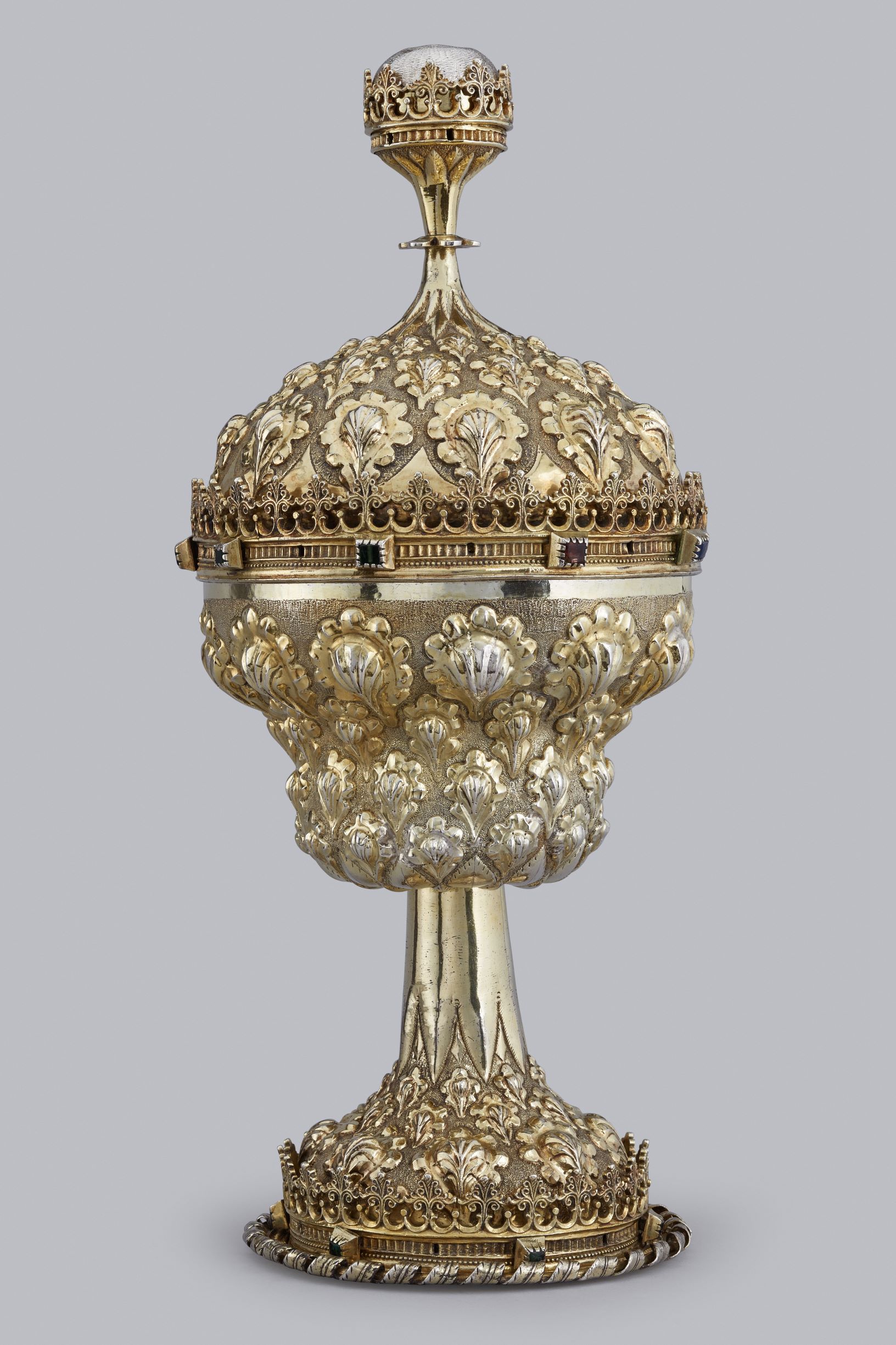
Election Cup, c. `1470 [Si1]
Unmarked, c. 1470
Silver gilt with applied pastes: H. 42 cm, D. 18 cm, 2056 g
This cup takes its name from the examination for new scholars of Winchester College, which is known as ‘Election’. It was presented in 1555 by John White (1510–60), a former Warden of Winchester, who wrote that he was sending ‘thys pore cownterfetyd cuppe, whyche I desire maye remayne as an ymplemente of The election hereafter’.
Election Cup has no hallmarks and there are only a handful of medieval silver cups with which it may be compared. There has been considerable debate about its date of manufacture, but most scholars now believe that it was made in the second half of the 15th century. White’s description of it as a ‘pore cownterfetyd cup’ probably meant that it was damaged and in an old-fashioned style.
The cup is in the shape of a gourd, with stylized leaves embossed on a matted ground. Traces of the original enamelling remain on the finial. Holes around the rim and the foot indicate that it was originally decorated with thirty-six jewels. Ten of these were already missing in 1557 and only seventeen now remain.
Exhibited: Paris Exposition Universelle, April-November 1867, section: ‘History of Labour Before 1800’, no. 222; ‘Gothic: Art for England’, Victoria and Albert Museum, London, October 2003 – January 2004, no. 185.
Literature: Percy MacQuoid, ‘The Plate of Winchester College’, The Burlington Magazine, Vol. 2, no. 5 (July 1903), p. 155, plate 1; Edward Alfred Jones, The Old Plate of the Cambridge Colleges (Cambridge, 1910), pp. xvii, xix; Charles James Jackson, An Illustrated History of English Plate, 2 vols (London, 1911), pp. 653-4 (illustrated); Encyclopaedia Britannica (London, 1911), ‘plate’; W.H. Frere (ed), Registrum Johannis Whyte: Episcopi Wintoniensis (London, 1914), p. ?; W.W. Watts, Old English Silver (London, 1924), pp. 27-8, plate 12; Winchester College: its buildings historu and customs (Winchester, 1926), p. 77; E. Alfred Jones, Old Silver of Europe and America from Early Times to the Nineteenth Century (Philadelphia, 1928), pp. 92-94, Gerald Taylor, Silver (London, 1956), p. 77, plate 5; Charles Oman, ‘The Winchester College Plate’, The Connoisseur (January, 1962), p. 27 (illustrated); John K.D. Cooper, ‘A Re-Assessment of Some English Late Gothic and Early “Renaissance” Plate – II, The Burlington Magazine, 119 (1977), p. 473 (illustrated); Philippa Glanville, Silver in Tudor and Early Stuart England (London, 1993) pp. 147, 248 (illustrated); R. Marks and P. Williamson (eds.), Gothic: Art for England, 1400-1547 (London, 2003), pp. 316-17 (illustrated); James Fenton, ‘The Last English Style’, The New York Review, 18 December 2003; J. Rosenthal, Margaret Peston’s Piety (Basingstoke, 2010), p. ?; J. McCormick, George Santayana’s Marginalia (Cambridge, Mass., 2011), vol 2, p. 411; Timothy Schroder, ‘The Cockayne Cups’, Silver Studies, no. 28 (2012), pp. 7-8; R. Foster, Winchester College Treasury: a guide to the collections (Winchester, 2016), pp. 9, 18-19 (illustrated); R. Foster (ed.), 50 Treasures from Winchester College (London, 2019), pp. 15, 64-65 (illustrated); Andrew French, Science by Simulation – Volume 1: a Mezze of Mathematical Models (London, 2022), p. 10, fig. 1.2a.
Provenance: Given to Winchester College by John White (1510-60), 1555
Location: Treasury, Gallery 1